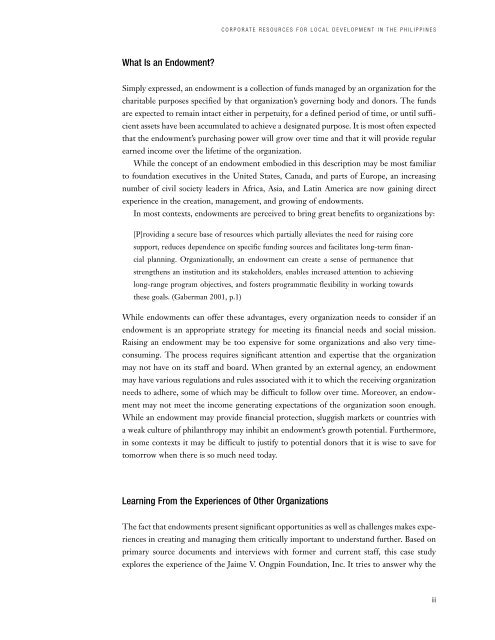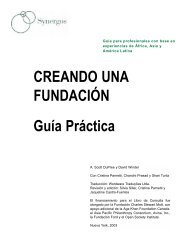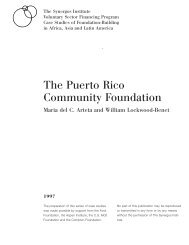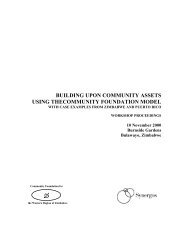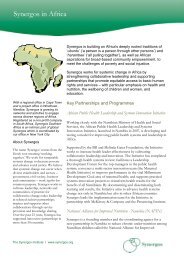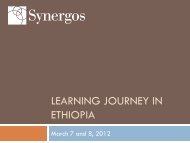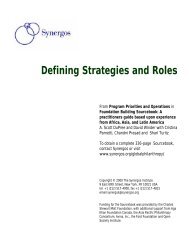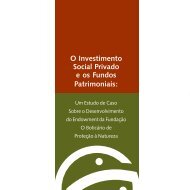Download full text of paper (PDF) - Synergos
Download full text of paper (PDF) - Synergos
Download full text of paper (PDF) - Synergos
Create successful ePaper yourself
Turn your PDF publications into a flip-book with our unique Google optimized e-Paper software.
CORPORATE RESOURCES FOR LOCAL DEVELOPMENT IN THE PHILIPPINES<br />
What Is an Endowment?<br />
Simply expressed, an endowment is a collection <strong>of</strong> funds managed by an organization for the<br />
charitable purposes specified by that organization’s governing body and donors. The funds<br />
are expected to remain intact either in perpetuity, for a defined period <strong>of</strong> time, or until sufficient<br />
assets have been accumulated to achieve a designated purpose. It is most <strong>of</strong>ten expected<br />
that the endowment’s purchasing power will grow over time and that it will provide regular<br />
earned income over the lifetime <strong>of</strong> the organization.<br />
While the concept <strong>of</strong> an endowment embodied in this description may be most familiar<br />
to foundation executives in the United States, Canada, and parts <strong>of</strong> Europe, an increasing<br />
number <strong>of</strong> civil society leaders in Africa, Asia, and Latin America are now gaining direct<br />
experience in the creation, management, and growing <strong>of</strong> endowments.<br />
In most con<strong>text</strong>s, endowments are perceived to bring great benefits to organizations by:<br />
[P]roviding a secure base <strong>of</strong> resources which partially alleviates the need for raising core<br />
support, reduces dependence on specific funding sources and facilitates long-term financial<br />
planning. Organizationally, an endowment can create a sense <strong>of</strong> permanence that<br />
strengthens an institution and its stakeholders, enables increased attention to achieving<br />
long-range program objectives, and fosters programmatic flexibility in working towards<br />
these goals. (Gaberman 2001, p.1)<br />
While endowments can <strong>of</strong>fer these advantages, every organization needs to consider if an<br />
endowment is an appropriate strategy for meeting its financial needs and social mission.<br />
Raising an endowment may be too expensive for some organizations and also very timeconsuming.<br />
The process requires significant attention and expertise that the organization<br />
may not have on its staff and board. When granted by an external agency, an endowment<br />
may have various regulations and rules associated with it to which the receiving organization<br />
needs to adhere, some <strong>of</strong> which may be difficult to follow over time. Moreover, an endowment<br />
may not meet the income generating expectations <strong>of</strong> the organization soon enough.<br />
While an endowment may provide financial protection, sluggish markets or countries with<br />
a weak culture <strong>of</strong> philanthropy may inhibit an endowment’s growth potential. Furthermore,<br />
in some con<strong>text</strong>s it may be difficult to justify to potential donors that it is wise to save for<br />
tomorrow when there is so much need today.<br />
Learning From the Experiences <strong>of</strong> Other Organizations<br />
The fact that endowments present significant opportunities as well as challenges makes experiences<br />
in creating and managing them critically important to understand further. Based on<br />
primary source documents and interviews with former and current staff, this case study<br />
explores the experience <strong>of</strong> the Jaime V. Ongpin Foundation, Inc. It tries to answer why the<br />
iii


